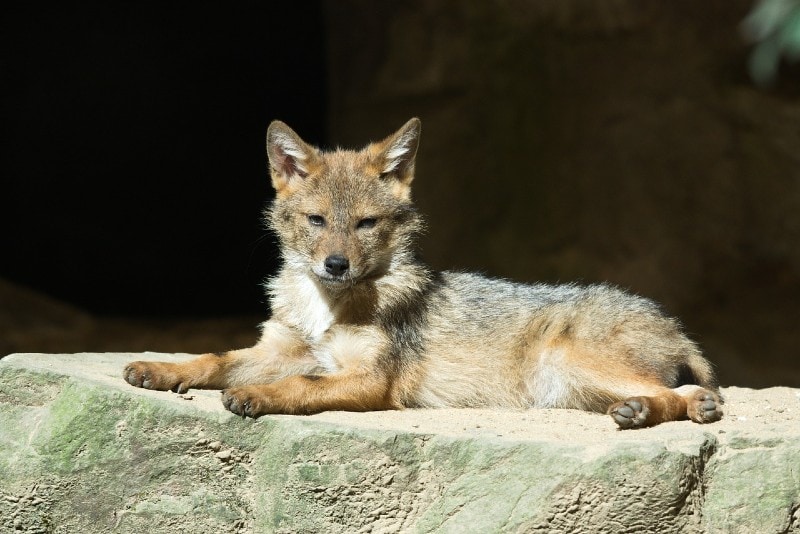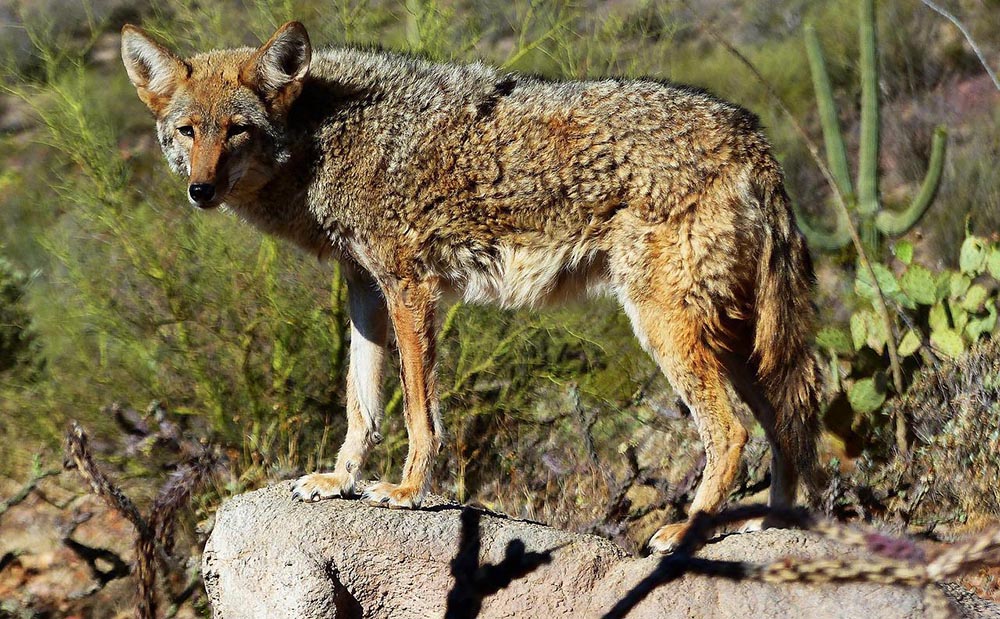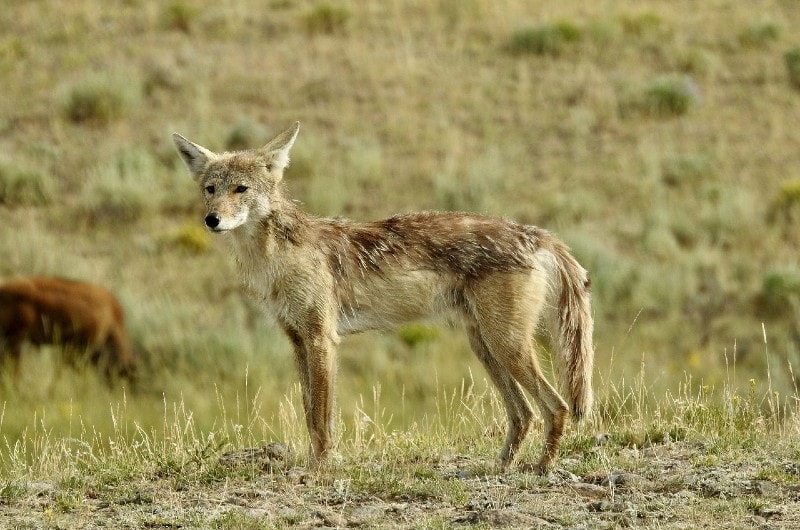Can Coyotes See Infrared Light? The Surprising Answer!
Last Updated on

As it stands, the verdict is no, coyotes cannot see infrared light. But the truth is, there’s still doubt out there. Nobody really knows for sure what this species sees, or even why their ocular systems are sort of different from what we’re used to seeing in other animals. Experts assume that their eyes work the same way those of dogs do. But coyotes are full of mysteries, so we still have a long way to go, in terms of studies related to their eyesight.
The only thing we can say for certain is that they see our world from a very different prism. It’s not all “black and white” when it comes to them. And seeing as we’re often relentless in this search for knowledge, we felt the only way to comprehend this difference is by drawing parallels with what we already know.
Read on, if you’d like to know what we discovered.

Do Coyotes Have 20/20 vision?
A normal human being will have a 20/20 vision. If you compare that to the coyotes, you’ll learn that they are nearsighted. Researchers who’ve had the opportunity to study a sample of their population have discovered that their vision is around 20/75 (similar to dogs) and sometimes worse. That means the odds of you seeing objects that are farther away are greater than those of the coyotes.
Sadly though, coyotes outmatch us in a different aspect—that of peripheral vision. While we are only able to see objects that are within a 180-degree space, they can see anything that’s within a 260-degree space.
It’s because of this gift that they are able to quickly pick up any form of movement in their vicinity, even before they identify the object.

Is The Prairie Wolf Color Blind?
First off, just so we’re clear, the prairie wolf is the other name of a coyote. Some know it as the American jackal, little wolf, cased wolf, or brush wolf. Scientists prefer calling it the Canis latrans, seeing as it’s a New World member of the Canidae family. The only difference between it and the actual wolf family (Canis lupus) is that it’s relatively smaller in size and weighs less.
Now that that’s out of the way, the answer to the question is, no. This species isn’t color blind but is sort of limited on the color spectrum.
We’re able to see a wide variety of colors on the spectrum, but the prairie wolf can only see blue and yellow. If you put an orange object in front of it, the shade will appear gray. And it’s the same observation with green, red, pink, and every other color.
Are UV Rays and Infrared Visible to Coyote?
It’s imperative to take note of the fact that coyotes are mammals—a mammal is any vertebrate with hair/fur and mammary glands. Scientists have tested nearly all mammals on the planet and determined that they cannot see infrared light/rays/radiation. They say the reason behind this is that their bodies can generate and release their own heat.
That’s what makes cold-blooded animals different. They have evolved and developed biological “accessories” that assist them in detecting infrared. Because the coyote is warm-blooded, we assume it cannot see infrared. Also, the few that have been tested haven’t quite shown any signs that they were able to detect infrared.

UV light is a different story. Initially, we assumed they couldn’t see it because we (humans) couldn’t. But thanks to technology, we’ve been able to conduct in-depth research into that subject. Today, we’re 100% sure that they are able to detect a small UV visual spectrum.
The one thing that made us suspect that they could detect UV light was their ability to see blue. Blue is a color that’s closest to UV light on the spectrum, so why not? To top that off, scientists say that they have proof that these animals can tell a piece of clothing has been washed using detergents that contain fluorescent whitening agents.
Do Coyotes Struggle to See in The Dark?
Coyotes are naturally diurnal. And we know this might come as a surprise considering they are mostly heard at night, but as we said, nature is full of mysteries. If they feel well rested during the day, they’ll spend the rest of the night hunting.
And hunting is a lot easier under the cover of darkness because that 20/75 vision improves drastically. What’s more, they don’t have to fight for food with other animals at night, especially humans.
Can You See the Eyes of a Coyote in The Dark?
If there ever was a list of animals with the most reflective eyes, we bet the coyotes would be at the top. Even if you have poor vision at night, you cannot miss that big bright white glow. And you also cannot mistake it for anything else, seeing as they usually hunt in packs.
Several pairs of glowing and moving reflective dots are all the signs you need to make your judgment. Don’t stick around too long because those animals are notoriously known to attack pets, humans, and anything that makes them feel challenged.
What makes their eyes that reflective? Tapetum lucidum. It’s a biological reflector system, positioned behind the eye’s retina. They are mostly found in nocturnal species to assist them to enhance visual sensitivity in low-light settings. Thanks to this biological feature, and the increased retinal surface, coyotes are able to easily track their prey and hide from predators.
What’s The Natural Color of Coyote’s Eyes?
This right here is yet another mystery that the science community is trying to unravel. We took notice of the fact that their eyes don’t just have one hue, but several. If they are yellow, you’ll find several with different shades of yellow—ranging from golden brown all the way to lemon. We’ve also heard of sightings where hunters thought they were blackish-brown, reddish-brown, and even orange.
The rarest of them all are the ones that come in varying shades of green. Blue is mostly reserved for the young and juveniles, but a few coyotes in the adult population have maintained that color.

Does The Color of Coyote’s Eye Change as The Sun Sets?
No, we’ve never heard of such instances. If it’s yellow, it will remain yellow at night. The white glow that you often see whenever you flash your light at them is the reflective glow. It doesn’t mean that there’s a color change. Keen hunters always notice that there’s a tinge of the actual color in that glow. So, their reddish eyes will have a reddish-white glow.
Is The White Reflective Glow an Obvious Sign You’re Seeing a Coyote?
No, it’s not an obvious sign because that glow is a result of the tapetum lucidum. Any nocturnal animal that has this reflective system behind its retina will have eyes that glow white in the dark. So yes, you could be seeing a coyote, or maybe it’s just a deer.
Experienced hunters have a way of telling the difference between the coyote’s eyes and that of the deer. For example, you’ll find them trying to figure out where the eyes sit with respect to the space around them. If they are higher than a bush, it’s probably a deer. And if it’s lower and small, they’ll assume it’s a fox.

Conclusion
You can see why we said it’s not easy trying to figure these animals out. Their varying eye features and mystery has made it virtually impossible to come up with a concrete answer as to whether they can see infrared light. We just assume they can’t because they’ve not given us any reasons to speculate otherwise.
The only certainties are they grapple with nearsightedness, see better at night, and have a wider peripheral vision. Also—they are dangerous.
Featured Image Credit: Quality Stock Arts, Shutterstock
Table of Contents
- Do Coyotes Have 20/20 vision?
- Is The Prairie Wolf Color Blind?
- Are UV Rays and Infrared Visible to Coyote?
- Do Coyotes Struggle to See in The Dark?
- Can You See the Eyes of a Coyote in The Dark?
- What’s The Natural Color of Coyote’s Eyes?
- Does The Color of Coyote’s Eye Change as The Sun Sets?
- Is The White Reflective Glow an Obvious Sign You’re Seeing a Coyote?
- Conclusion
About the Author Robert Sparks
Robert’s obsession with all things optical started early in life, when his optician father would bring home prototypes for Robert to play with. Nowadays, Robert is dedicated to helping others find the right optics for their needs. His hobbies include astronomy, astrophysics, and model building. Originally from Newark, NJ, he resides in Santa Fe, New Mexico, where the nighttime skies are filled with glittering stars.
Related Articles:
Can You Use Binoculars to Look At Stars? How to Choose the Right Pair
How to Clean a Refractor Telescope: Step-by-Step Guide
How to Clean a Telescope Eyepiece: Step-by-Step Guide
How to Clean a Rifle Scope: 8 Expert Tips
Monocular vs Telescope: Differences Explained (With Pictures)
What Is a Monocular Used For? 8 Common Functions
How to Clean a Telescope Mirror: 8 Expert Tips
Brightfield vs Phase Contrast Microscopy: The Differences Explained
